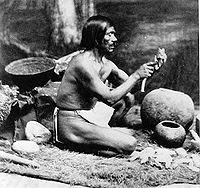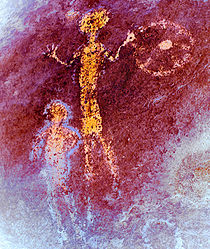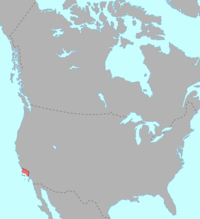- Chumash people
-
Chumash Total population 2,000[1]–5,000[2] Regions with significant populations  United States
United States  (California)
(California)Languages Religion Traditional tribal religion,
ChristianityRelated ethnic groups Barbareño, Ventureño,
Ynezeño, Purismeño, Obiseño[3]The Chumash are a Native American people who historically inhabited the central and southern coastal regions of California, in portions of what is now San Luis Obispo, Santa Barbara, Ventura and Los Angeles counties, extending from Morro Bay in the north to Malibu in the south. They also occupied three of the Channel Islands: Santa Cruz, Santa Rosa and San Miguel; the smaller island of Anacapa was uninhabited. Modern place names with Chumash origins include Malibu, Lompoc, Ojai, Pismo Beach, Point Mugu, Piru, Lake Castaic, Saticoy, and Simi Valley.
Archaeological research demonstrates that the Chumash have deep roots in the Santa Barbara Channel area and lived along the southern California Coast for millennia.
Contents
Population
Estimates for the pre-contact populations of most native groups in California have varied substantially. Alfred L. Kroeber thought that the 1770 population of the Chumash might have been about 10,000.[4] Alan K. Brown concluded that the population was not over 15,000.[citation needed] Sherburne F. Cook at various times estimated the aboriginal Chumash as 8,000, 13,650, 20,400, and 18,500.[5]
Some scholars[6] have suggested that Chumash population may have declined substantially during a "protohistoric" period (1542–1769 CE) when intermittent contacts with the crews of Spanish ships—including those of Juan Rodriguez Cabrillo's expedition who wintered in the Santa Barbara Channel in AD 1542-43—brought disease and death. But the Chumash appear to have been thriving in the late 18th century when Spaniards first began actively colonizing the California coast. Whether the deaths began earlier with the contacts with ships' crew, or only later with the construction of several Spanish missions at Ventura, Santa Barbara, Lompoc, Santa Inez, and San Luis Obispo, the Chumash were eventually devastated by Old World diseases such as influenza and smallpox, to which they had no immunological resistance. By 1900, their numbers had declined to just 200. Estimates of Chumash people today range from 2,000[1] to 5,000.[2]
Languages
Several related Chumashan languages were spoken. There are few if any living native speakers, although they are well documented in the unpublished fieldnotes of linguist John Peabody Harrington. Especially well documented are the Barbareño, Ineseño, and Ventureño dialects. Several Chumash families are working to revitalize the language.[7]
Culture
 Rafael Solares, a Samala chief. Captain of Soxtonoxmu, capital village in the Santa Ynez Valley. Photograph by Leon de Cessac, late 19th century.
Rafael Solares, a Samala chief. Captain of Soxtonoxmu, capital village in the Santa Ynez Valley. Photograph by Leon de Cessac, late 19th century.
The Chumash were hunter-gatherers and were adept at fishing at the time of Spanish colonization. They are one of the relatively few New World peoples who regularly navigated the ocean (another was the Tongva, a neighboring tribe located to the south). Some settlements built plank boats called tomols, which facilitated the distribution of goods and could even be used for whaling. Remains of a developed Chumash culture, including rock paintings apparently depicting the Chumash cosmology such as Chumash Painted Cave State Historic Park can still be seen.
Anthropologists eagerly sought Chumash baskets as prime examples of the craft, and two of the finest collections are at the Smithsonian Institution in Washington, DC and the Musée de l'Homme (Museum of Mankind) in Paris, France. The Museum of Natural History at Santa Barbara is believed to have the largest collection of Chumash baskets.
The Chumash of the Northern Channel Islands were at the center of an intense regional trade network. Beads made from olivella shells were manufactured on the Channel Islands and used as a form of currency by the Chumash.[8] These shell beads were traded to neighboring groups and have been found throughout Alta California. Over the course of late prehistory, millions of shell beads were manufactured and traded from Santa Cruz Island. It has been suggested that exclusive control over stone quarries used to manufacture the drills needed in bead production may have played a role in the development of social complexity in Chumash society.[8]
Scorpion tree
A centuries old oak tree in California is considered to have a Chumash arborglyph, a carving of a 6-legged creature with a headdress including a crown and two spheres. Previously thought to have been carved by cowboys, it was visited in 2007 by paleontologist Rex Saint Onge who identified the three foot carving as being of Chumash origin and related to other Chumash cave paintings in California. Further studies have led Saint Onge to believe that these are not simply the work of Chumash shamans but were conscious observations of the stars and part of a Chumash calendar.[9]
History
Before Spanish contact
The Chumash people thrived at a very early period in California prehistory, with some settlements dating to at least 10,000 years before present.[10] Sites of the Millingstone Horizon date from 7000 cal BC to 4500 cal BC; they evidence a subsistence system focused on the processing of seeds with metates and manos.[11] During that time people used bipointed bone objects and line to catch fish and began making beads from shells of the marine olive snail (Olivella biplicata).[12]
Some researchers believe the Chumash may have been visited by Polynesians between AD 400 and 800, nearly 1,000 years before Christopher Columbus reached The Americas.[13] Although the concept is rejected by most archaeologists who work with the Chumash culture, studies published in peer-reviewed journals have given the idea greater plausibility.[14][15] The Chumash advanced sewn-plank canoe design, which is used throughout the Polynesian Islands but is unknown in North America except by those two tribes, is cited as the chief evidence for contact. Comparative linguistics also may provide evidence as the Chumash word for "sewn-plank canoe," tomolo'o, may have been derived from kumulā'au, the Polynesian word for the redwood logs used in that construction. However, the language comparison is generally considered tentative. Furthermore, the development of the Chumash plank canoe is fairly well represented in the archaeological record and spans a time period of several centuries.[16][17]
Spanish Arrival and the Mission Era
Chumash people first encountered Europeans in the autumn of 1542, when two sailing vessels under Juan Cabrillo arrived on the coast from Mexico. Cabrillo died and was buried on San Miguel Island, but his men brought back a diary that contained the names and population counts for many Chumash villages, such as Mikiw. Spain claimed what is now California from that time forward, but did not return to settle until 1769, when the first Spanish soldiers and missionaries arrived with the double-purpose of Christianizing the Native Americans and facilitating Spanish colonization. By the end of 1770 missions and military presidios had been founded at San Diego to the south of Chumash lands and Monterey, to their north.[18]
The Chumash people moved from their villages to the Franciscan missions between 1772 and 1817. Mission San Luis Obispo, established in 1772, was the first mission in Chumash-speaking lands, as well as the northernmost of the five missions ever constructed in those lands. Next established, in 1782, was Mission San Buenaventura on the Pacific Coast near the mouth of the Santa Clara River. Mission Santa Barbara, also on the coast, and facing out to the Channel Islands, was established in 1786. Mission La Purisima Concepcion was founded along the inland route from Santa Barbara north to San Luis Obispo in 1789. The final Franciscan mission to be constructed in native Chumash territory was Santa Ynez, founded in 1804 on the Santa Ynez River with a seed population of Chumash people from Missions La Purisima and Santa Barbara. To the southeast, Mission San Fernando, founded in 1798 in the land of Takic Shoshonean speakers, also took in large numbers of Chumash speakers from the middle Santa Clara River valley. While most of the Chumash people joined one mission or another between 1772 and 1806, a significant portion of the native inhabitants of the Channel Islands did not move to the mainland missions until 1816.[19]
Modern times
The first modern Tomol was built and launched in 1976 as a result of a joint venture between Quabajai Chumash of The Coastal Band of the Chumash Nation and the Santa Barbara Museum of Natural History. The Tomol's name is Helek/Xelex, the Chumash word for falcon. The Brotherhood of the Tomol was revived and her crew paddled and circumnavigated around the Santa Barbara Channel Islands on a ten day journey, stopping on three of the islands. The second Tomol, the Elye'wun ("swordfish"), was launched in 1997.
On September 9, 2001, the first "crossing," in the Chumash tomol, from the mainland to Channel islands was sponsored by the Chumash Maritime Association and the Barbareno Chumash Council. Several Chumash bands and descendants gathered on the island of Limuw (the Chumash name for Santa Cruz island) to witness the tomol Elye'wun being paddled from the mainland to Santa Cruz island. Their journey was documented in the short film "Return to Limuw" produced by the Ocean Channel for the Chumash Maritime Association, Channel Islands National Marine Sanctuary, and the Santa Barbara Maritime Museum. The channel crossings have become a yearly event hosted by the Barbareno Chumash Council.
The Santa Ynez Band of Chumash are a federally recognized tribe with a casino on their reservation in Santa Ynez, California.
In addition to the Santa Ynez Band, the Coastal Band of the Chumash Nation, and the Barbareno/Ventureno tribal group are attempting to gain federal recognition. Other Chumash tribal groups include the Northern Chumash Tribal Council, descendants from the San Luis Obispo area, and the Barbareno Chumash Council, descendants from the greater Santa Barbara area.
The publication of the first Chumash dictionary took place in April 2008. Six hundred pages long and containing 4,000 entries, the "Samala-English Dictionary" includes more than 2,000 illustrations.[20]
See also
- Chumash traditional narratives
- Pre-Columbian trans-oceanic contact
- Polynesian navigation
- Dentalium neohexagonum
- Painted Rock
- Chumash Painted Cave State Historic Park, California
- Burro Flats Painted Cave
- Shalawa Meadow, California
Notes
- ^ a b "California Indians and Their Reservations: P. SDSU Library and Information Access. (retrieved 17 July 2010)
- ^ a b Native Inhabitants
- ^ Pritzker, 121
- ^ A. L. Kroeber, p.883
- ^ S. F. Cook, 1976
- ^ Erlandson et al. 2001
- ^ Mithun 1999:389-392.
- ^ a b Arnold 2001
- ^ Kettman, Max "A Tree Carving in California: Ancient Astronomers?" Time Magazine 9 February 2010 [1]
- ^ C. M. Hogan, 2008
- ^ Glassow et al. 2007:192-196
- ^ King 1990:80-82, 106-107, 231
- ^ Did ancient Polynesians visit California? Maybe so., San Francisco Chronicle
- ^ For articles on the Polynesian contact theory, see Jones, Terry L.; Kathryn A. Klar (June 3, 2005). "Diffusionism Reconsidered: Linguistic and Archaeological Evidence for Prehistoric Polynesian Contact with Southern California" ([dead link] – Scholar search). American Antiquity 70 (3): 457–484. doi:10.2307/40035309. JSTOR 40035309. http://www.saa.org/publications/AmAntiq/70-3/Jones.html. Retrieved 2008-03-06.[dead link], and Adams, James D.; Cecilia Garcia and Eric J. Lien (January 23, 2008). "A Comparison of Chinese and American Indian (Chumash) Medicine". Evidence-based Complementary and Alternative Medicine 7 (2): 219. doi:10.1093/ecam/nem188. PMC 2862936. PMID 18955312. http://ecam.oxfordjournals.org/cgi/content/full/nem188v1. Retrieved 2008-03-06.. See also Terry Jones's homepage, California Polytechnic State University.
- ^ For the argument against the Polynesian Contact Theory, see 2007 Arnold, J.E. “Credit Where Credit is Due: The History of the Chumash Oceangoing Plank Canoe.” American Antiquity 72:196-209
- ^ Arnold, Jeanne E. 1995.
- ^ Gamble, Lynn H. 2002.
- ^ Brown 1967
- ^ McLendon and Johnson 1999
- ^ Santa Ynez Band of Chumash Indians Publishes Language Dictionary. (http://www.reuters.com/article/pressRelease/idUS180466+21-Apr-2008+PRN20080421)
References
- Arnold, Jeanne E. (ed.) 2001. The Origins of a Pacific Coast Chiefdom: The Chumash of the Channel Islands. Salt Lake City: University of Utah Press.
- Arnold, Jeanne E. 1995. "Transportation Innovation and Social Complexity among Maritime Hunter-Gatherer Societies." American Anthropologist 97:733-747.
- Brown, Alan K. 1967. "The Aboriginal Population of the Santa Barbara Channel". University of California Archaeological Survey Reports 69:1-99.
- Cook, Sherburne F. 1976. The Conflict between the California Indian and White Civilization. University of California Press, Berkeley.
- Cook, Sherburne F. 1976. The Population of the California Indians, 1769-1970. University of California Press, Berkeley.
- Erlandson, Jon M., Torben C. Rick, Douglas J. Kennett, and Philip L. Walker. 2001. Dates, demography, and disease: Cultural contacts and possible evidence for Old World epidemics among the Island Chumash. Pacific Coast Archaeological Society Quarterly 37(3):11-26.
- Gamble, Lynn H. 2002. Archaeological Evidence for the Origin of the Plank Canoe in North America. American Antiquity 67(2):301-315.
- Glassow, Michael A., Lynn H. Gamble, Jennifer E. Perry, and Glenn S. Russell. 2007. Prehistory of the Northern California Bight and the Adjacent Transverse Ranges. In California Prehistory: Colonization, Culture, and Complexity. Terry L. Jones and Kathryn A. Klar, editors. New York and Plymouth UK: Altamira Press.
- Hogan, C.Michael. 2008. Morro Creek. Ed. A. Burnham.
- Jones, Terry L., and Kathryn A. Klar. 2005. "Diffusionism Reconsidered: Linguistic and Archaeological Evidence for Prehistoric Polynesian Contact with Southern California". American Antiquity 70:457-484.
- King, Chester D. 1991. Evolution of Chumash Society: A Comparative Study of Artifacts Used for Social System Maintenance in the Santa Barbara Channel Region before A.D. 1804. New York and London, Garland Press.
- Kroeber, A. L. 1925. Handbook of the Indians of California. Bureau of American Ethnology Bulletin No. 78. Washington, D.C.
- McLendon, Sally and John R. Johnson. 1999. Cultural Affiliation and Lineal Descent of Chumash Peoples in the Channel Islands and the Santa Monica Mountains. 2 volumes. Prepared for the Archeology and Ethnography Program, National Park Service by Hunter College, City University of New York and the Santa Barbara Museum of Natural History.
- Mithun, Marianne. (1999). The languages of Native North America. Cambridge: Cambridge University Press. ISBN 0-521-23228-7 (hbk); ISBN 0-521-29875-X.
- Pritzker, Barry M. A Native American Encyclopedia: History, Culture, and Peoples. Oxford: Oxford University Press, 2000. ISBN 978-0195138771.
Further reading
- Hudson, D. Travis and Thomas C. Blackburn. 1982-7. The Material Culture of the Chumash Interaction Sphere Volumes I–V. Anthropological Papers No. 25-31. Menlo Park, CA: Ballena Press.
- Hudson, D. Travis, Thomas Blackburn, Rosario Curletti and Janice Timbrook. 1977. The Eye of the Flute: Chumash Traditional History and Ritual as told by Fernando Librado Kitsepawit to John P. Harrington. Santa Barbara Museum of Natural History.
- Hudson, D. Travis, Janice Timbrook, and Melissa Rempe. 1977. Tomol: Chumash Watercraft as Described in the Ethnographic Notes of John P. Harrington. Anthropological Papers No. 9, edited by Lowell J. Bean and Thomas C. Blackburn. Socorro, NM: Ballena Press.
External links
- Santa Ynez Band of Chumash Indians
- Inezeño Chumash Language Tutorial
- Chumash Casino
- Coastal Band of the Chumash Nation
- Antelope Valley Indian Museum at California Department of Parks and Recreation
- Native Cultures and the Maritime Heritage Program, NOAA
- Barbareno Chumash Council
- Northern Chumash Tribal Council
- Chumash Painted Cave State Historic Park
- Chumash Singer and Storyteller Julie Tumamait-Stenslie
- Chumash Indian Museum, Thousand Oaks, CA
Indigenous peoples of California Achomawi · Atsugewi · Bay Miwok · Cahuilla · Chemehuevi · Chimariko · Chumash · Coast Miwok · Cupeño · Eel River Athapaskans (Lassik, Nongatl, Sinkyone, Wailaki) · Esselen · Gabrielino (Tongva) · Halchidhoma · Hupa (Chilula, Whilkut) · Juaneño (Acjachemen) · Karuk · Kato · Kawaiisu · Kitanemuk · Kumeyaay (Diegueño, Ipai, Tipai) · Lake Miwok · Luiseño · Maidu · Mattole (Bear River) · Modoc (Klamath) · Mohave · Mono (Monache, Owens Valley Paiute) · Nomlaki · Northern Paiute · Ohlone (Costanoan) · Patwin · Pomo · Quechan (Yuma) · Salinan · Serrano · Shasta (Konomihu, Okwanuchu) · Tataviam · Timbisha · Tolowa · Tübatulabal · Valley and Sierra Miwok · Wappo · Washoe · Wintu · Wiyot · Yana · Yokuts · Yuki · Yurok
Categories:- Chumash people
- California Mission Indians
- Native American tribes in California
- Native American history of California
Wikimedia Foundation. 2010.


